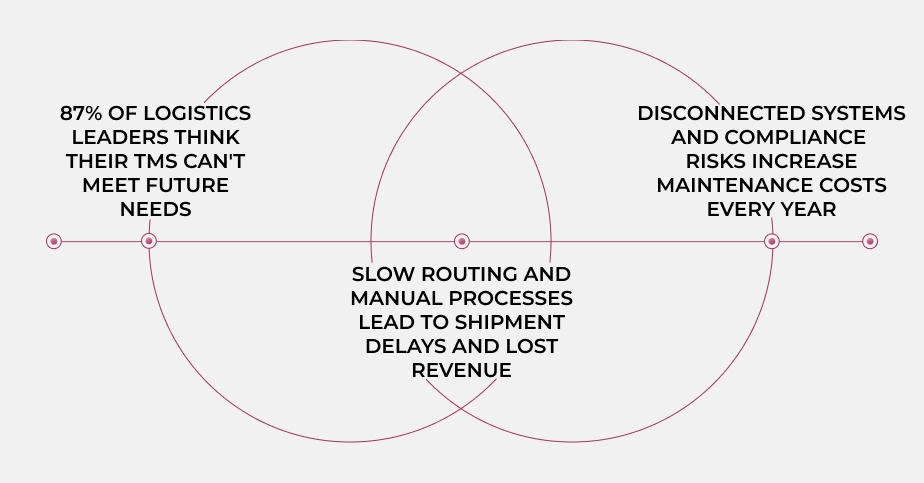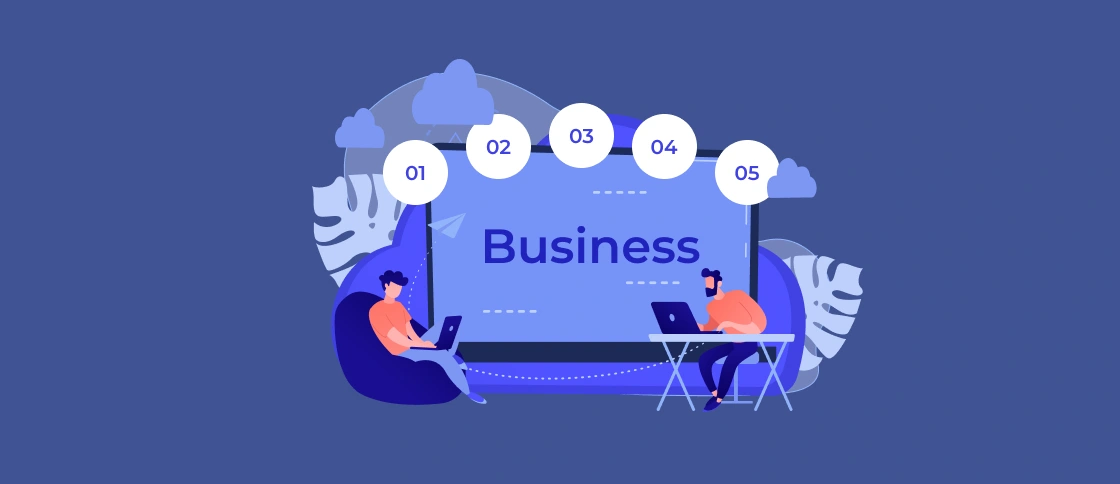- Key Takeaways
- Why Modernize Logistics and TMS Now
- What a Modern TMS Looks Like
- Cloud-Ready Architecture
- Extensibility and APIs
- Seamless Integration Map
- User Experience
- Pain Signals: When Legacy Systems Hold You Back
- The Business Case and ROI
- Modernization Paths: Replatform, Refactor, Re-architect
- Microservices and API-First Logistics
- Platform Choices in Delphi and .NET Environments
- TMS Software Modernization: Key Capabilities
- TMS System Modernization: Replace or Augment
- Security-by-Design and Compliance
- Data, Analytics and AI in Transportation
- DevOps, SRE and Operability
- Roadmap, KPIs and Next Steps
- Softacom Can Help
- Conclusion
In the supply chain, each minute delayed translates into dollars lost. But most businesses run on legacy systems, unable to handle today’s volumes and speed. Routing is too slow. Carrier data is stored in isolation. Small changes to the configuration threaten system downtime. Those inefficiencies bleed margins and add risk throughout the supply chain.
That is why TMS software modernization is a priority for logistics leaders. Modernizing the TMS system makes transportation management competitive. Integration must be enhanced, new functionality facilitated, and security enhanced. Then, TMS platforms will run faster and safer regardless of market volatility.
Key Takeaways
- Modernization reduces costs and enables real-time visibility.
- Event-driven architecture minimizes downtime and operational risk.
- Phased modernization delivers measurable ROI.
- Data integrity and automation drive long-term success.
- Choosing the right partner ensures a smooth migration and integration process.
Why Modernize Logistics and TMS Now
Modernization has become a strategic imperative for logistics organizations that face complex operations. Existing transport management systems have often been built decades ago. Leaders acknowledge that these systems cannot keep pace with modern business demands. Mexico Business News reports that 87 % of logistics leaders think their TMS can’t meet future needs. Almost half spend more than 10% of their budgets to fix issues with old systems.
The pressure has multiple facets. The businesses have diminishing profit margins coupled with the need for up-to-the-minute transparency. Compliance regulations like GDPR and CCPA come with many complexities and risks. So, the business needs to redesign the supply chain management system.
Organizations that opt for legacy modernization early gain a distinct competitive edge. TMS system modernization enables faster responses to market changes and built-in resilience. It unlocks new features such as predictive analytics and exception automation. These capabilities optimize cost to serve and reduce risk exposure.

What a Modern TMS Looks Like
A modern TMS is built for agility. It is often a collection of modular services that can evolve independently. Each service (load planning, freight forwarder’s software, carrier management) can be scaled or replaced.
In older systems, business logic is hardwired into user interfaces. A modern TMS separates business logic from infrastructure. This allows teams to introduce new features through effective software development without rewriting the entire application.
Integration is the foundation. New platforms expose functionality through secure APIs. This enables data exchange with ERP, WMS, CRM or telematics systems. Event-driven design lets the TMS quickly respond to changes in the logistics network.
These capabilities allow logistics organizations to respond faster and add new functionality. Teams don’t wait months for system upgrades. They can deploy new modules and third-party integrations in days.
Cloud-Ready Architecture
Layered services and microservices make it easy to add or replace modules. Event streaming and Change Data Capture (CDC) ensure data consistency across distributed systems.
Extensibility and APIs
Modern systems are designed for extensibility. SDKs and low-code surfaces allow rapid adaptation without rewriting the core application. Business users can configure workflows or add new functionality without full re-development cycles.
Seamless Integration Map
A TMS connects effortlessly with ERP, WMS, telematics, EDI and finance systems. Integration eliminates data silos and enables real-time tracking across the value chain.
User Experience
A well-designed TMS provides interfaces tailored to individual responsibilities. Planners get visibility into shipment progress and capacity utilization. Drivers see mobile dashboards for real-time routing and proof of delivery. Financial teams access automated invoicing and analytics views.
At the management level, control-tower dashboards consolidate this information into a single environment. There, decision-makers can monitor exceptions and performance trends across the network.
Crucially, configuration drives this user experience rather than customization. Administrators can change workflows and approval processes using settings. This avoids modifying core hard-coding logic. This approach simplifies maintenance and ensures system consistency. The result is a user experience that adapts to change.
Pain Signals: When Legacy Systems Hold You Back
Many companies delay legacy modernization until their systems start breaking. Common warning signs include:
- Manual tendering and slow rate calculations
- Data re-entry between disconnected systems
- Outdated encryption or a lack of role-based access
- Siloed data creating inaccurate ETAs
- Inconsistent master data across trading partners
These issues increase operational costs and expose businesses to compliance and security risks.
The Business Case and ROI
Modernization directly improves performance metrics. Companies experience measurable reductions in accessorial costs and chargebacks. Automation alone can cut manual workload by 20-30%. Predictive optimization and carrier compliance uplift further enhance profitability. A phased ROI approach helps organizations confirm gains and mitigate risks before rollout.
Modernization Paths: Replatform, Refactor, Re-architect
Choosing the right path to legacy modernization helps control risk and ensures predictable results. Here are the alternatives:
- Replatform. Move to modern infrastructure, such as containers or cloud hosting.
- Refactor. Optimize code and architecture for performance and maintainability.
- Re-architect. Redesign into microservices for long-term scalability.
“Strangler-fig” approach minimizes cutover risk and maintains business continuity. Here, you don’t need to replace everything at once. You introduce new modules alongside legacy ones. Workloads are gradually shifted to the new environment. This allows both systems to coexist during migration.
At the same time, there are anti-patterns to avoid. The most common mistakes are:
- Big-bang rewrites that attempt to rebuild the entire system from scratch.
- “Forklift” migrations transfer old logic to a new host without rethinking the processes.
These shortcuts often undermine the goals of modernization. A phased, well-governed roadmap is what leads to true modernization success.
Microservices and API-First Logistics
Modern TMS modernization relies on decomposing tightly coupled legacy systems into modular domains. For example, orders, tendering, rating, tracking and settlement.
Event-driven updates and API-first design ensure real-time responsiveness. Versioned APIs and partner portals let carriers and brokers self-integrate without IT overhead.
Platform Choices in Delphi and .NET Environments
For systems built in Delphi, interoperability remains viable. Companies can modernize in stages. They use custom Delphi development or refactor core modules. This helps preserve proven business logic at the same time.
Custom .NET development and Azure modernization help with containerization and serverless functions. Automated testing and blue/green deployments support zero-downtime transitions.
TMS Software Modernization: Key Capabilities
Modernized systems excel in four capability pillars: planning, execution, visibility and settlement. Together, they form the foundation for data-driven logistics operations. MDM ensures data consistency across systems. These pillars define modern logistics success.
TMS System Modernization: Replace or Augment
Some enterprises completely replace outdated systems. And others augment them with satellite modules. The right approach depends on how deeply the current system supports business goals.
Side-by-side greenfield deployment with adapters allows for gradual migration. In this case, you retire legacy modules only when their replacements are validated.
Hybrid buy–build strategies combine COTS reliability with custom differentiation. This is ideal for organizations seeking a balance between innovation and stability.
Security-by-Design and Compliance
When modernizing, you should have security from day one. End-to-end encryption is a top requirement. Zero-trust architecture and least-privilege access to IAM resist malicious access. GDPR, CCPA and HAZMAT regulation compliance will prevent fines.
Data, Analytics and AI in Transportation
Data is the foundation of every modernization effort. Modern TMS platforms integrate predictive models for ETA forecasting and anomaly detection.
Control-tower KPIs like OTIF and cost per shipment enable real-time decision-making. Data lineage and MLOps pipelines ensure reliable AI-driven insights and sustainable optimization.
DevOps, SRE and Operability
Infrastructure as Code, CI/CD pipelines and automated tests shorten release cycles. They also reduce human error. Observability enables continuous monitoring. On-call playbooks and retrospectives improve reliability and operational resilience.
Roadmap, KPIs and Next Steps
Every modernization journey begins with discovery and audit. You need to evaluate systems, data, security, and technical debt. From there, organizations develop a roadmap with clear KPIs. Arrange user training and transparent communication. This will help ensure adoption and measurable success among users.
Softacom Can Help
Softacom provides end-to-end expertise in legacy application modernization services. We help logistics organizations rebuild and scale critical systems. Our team has experience in modernizing and migrating TMS software and containerization in manufacturing. We work with both Delphi and .NET.
Softacom ensures a controlled transformation aligned with your business goals. Reach out to us today.
Conclusion
TMS system modernization is a business necessity. Companies that modernize today gain operational agility and actionable data visibility. The right modernization roadmap helps leaders transform legacy systems into long-term assets.






